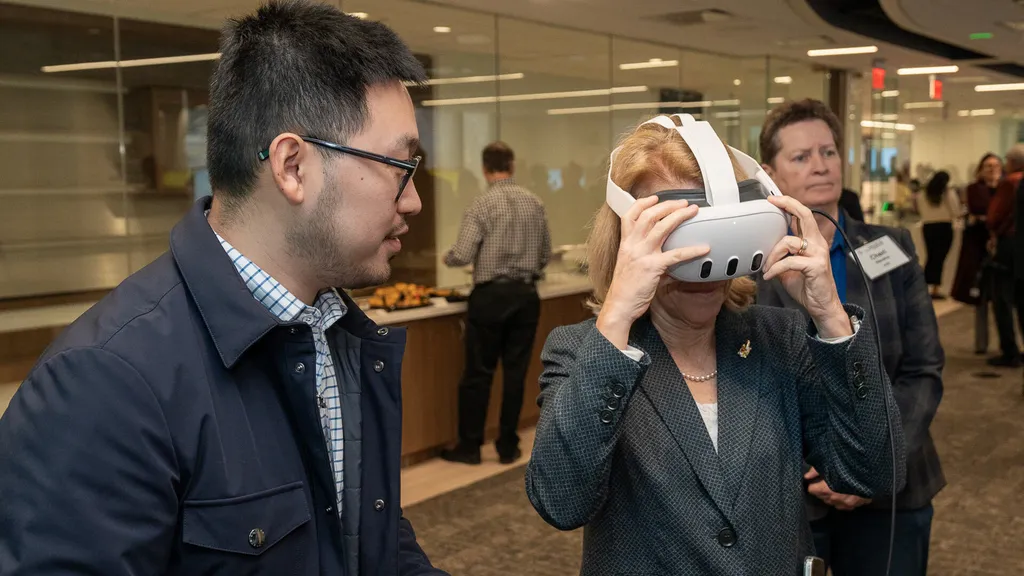- November 26, 2024
- By Maryland Today Staff
Uncovering bias in AI models used in medical diagnosis. Identifying patients with potentially life-threatening antibiotic-resistant infections. Predicting the spread of disease with advanced computing.
These are just a few of the advances in medical care in the works at the University of Maryland Institute for Health Computing (UM-IHC), which uses high-performance computing and artificial intelligence to benefit public health in ways unimaginable just a few years ago.
The institute welcomed dozens of leaders from Montgomery County, state government, life science companies and federal agencies to its headquarters in North Bethesda on Monday for a ribbon-cutting ceremony and research showcase to celebrate its second anniversary. At the event, UM-IHC leaders also announced new partnerships with industry and the federal government.
“We are truly poised to take advantage of these breakthroughs because of our location, our partnerships with biotech companies right here in Montgomery County, and of course, wonderful agencies such as NIH, FDA and NIST,” said University of Maryland, College Park President Darryll J. Pines.
UM-IHC’s 27,000-square-foot temporary workspace is located along the county’s I-270 biotech corridor—a 15-mile stretch that includes more than 300 life science companies employing some 26,000 people. This past summer, county officials began seeking a developer to build a major transit-oriented life sciences center anchored by UM-IHC at the North Bethesda Metrorail Station.

UM-IHC’s accomplishments to date include 10 industry partnerships formed, more than 150 scientific papers published, two scientific patents submitted, 26 grant applications submitted in just the last quarter, and one spin-off company launched. More than 70 faculty and staff members now call the North Bethesda headquarters home.
All of this innovation energy is the result of blending the advanced computing expertise of UMCP, clinical and biomedical research experts from the University of Maryland, Baltimore (UMB) and a vast database of health information provided by the University of Maryland Medical System (UMMS). The shared goal is to improve well-being and quality of life, fight disease and enhance outcomes for all people across Maryland and beyond. The center also provides new educational and employment opportunities to the community, said Montgomery County Executive Marc Elrich.
“I'm really happy that we … achieved something we looked for in Montgomery County, which is bringing an academic research institution into Montgomery County,” he said. “We also hope the institute, with its research internships and fellowship opportunities, will help us expand our life sciences and tech workforce.”
UM-IHC receives funding support from the University of Maryland Strategic Partnership: MPowering the State and Montgomery County.
UM-IHC Co-executive Directors Bradley Maron and Adam Porter and Co-director Warren D’Souza shared with the more than 100 attendees examples of UM-IHC’s new partnerships and projects, including a project in which UM-IHC researchers are working with AstraZeneca to develop better models to identify Maryland residents at high risk for preventable diseases, including lung cancer. They also announced partnerships with 20/20 Gene Systems and United States Pharmacopeia.
In addition, National Institutes of Health (NIH) researchers will work alongside UM-IHC researchers on site to help predict antibiotic resistance in patients with severe infections when they enter a hospital, and Food and Drug Administration (FDA) researchers will work on site to detect bias in artificial intelligence (AI) used in medical software systems.
“I'm very excited to announce … that we are in final stages of an agreement that will allow for FDA scientists to actually be here in this floor, working alongside university researchers and clinicians,” said Aldo Badano, director of the FDA’s Division of Imaging, Diagnostics and Software Reliability. “This convergence between the FDA regulatory science expertise and the IHC’s innovation—in the university systems, in the health systems and also industries that are associated in the partnership—really promises to bring benefits to patients, which is always our first customer at FDA, but also in workforce development, which FDA really appreciates.”
Following a ribbon-cutting ceremony, UM-IHC researchers shared projects they’re working on with real-world impact, and guests donned a headset to experience a virtual reality training module for physician assistants.
Other individuals who participated in the ribbon-cutting included Dels. Jared Solomon, Sarah Wolek and Teresa Woorman; Montgomery County Councilmembers Marilyn Balcombe, Andrew Friedson, Will Jawando, Laurie-Anne Sayles and Kate Stewart; UMB President Bruce E. Jarrell, Provost Roger Ward and School of Medicine Dean Mark Gladwin; and UMCP Senior Vice President and Provost Jennifer King Rice and College of Computer, Mathematical, and Natural Sciences Dean Amitabh Varshney.
Reflecting on the months leading up to UM-IHC’s formation two years earlier, Jarrell said critics doubted such an ambitious collaboration between the three institutions could ever work.
“In fact, they fit together remarkably well,” he said. “And what we found out was that our medical system was really very advanced, not just in keeping data—and I don't want to underestimate the keeping of the data as important—but also in interpreting the data with AI, with feet on the ground, with practical implications of here's what these data mean when you actually are taking care of patients.”
The patient data Jarrell referred to are the de-identified, encrypted and HIPAA-protected health records of 2 million Marylanders.
“The value of the data that the medical system brings is defined by the diversity of the data, which represents the diversity of the communities that we are blessed to serve,” said UMMS President and CEO Mohan Suntha. “So, what's the vision? What do you expect us to be? I want you to think Silicon Valley. I want you to think about the future of health care computing and the ability to impact the nation and the world, to solve big health care problems.”
This article was based on an original text by Alex Likowski.
